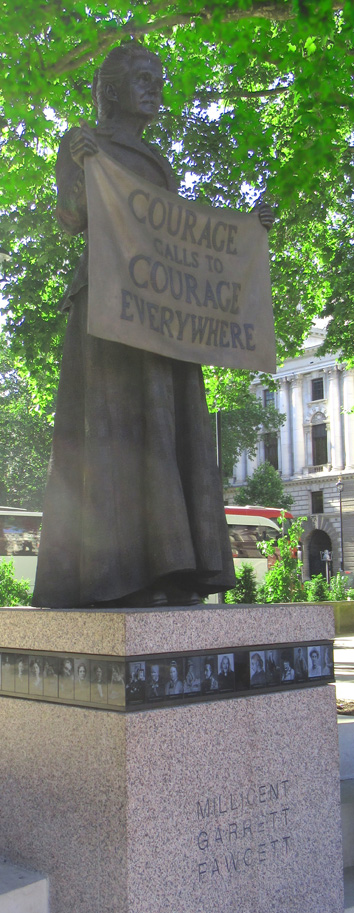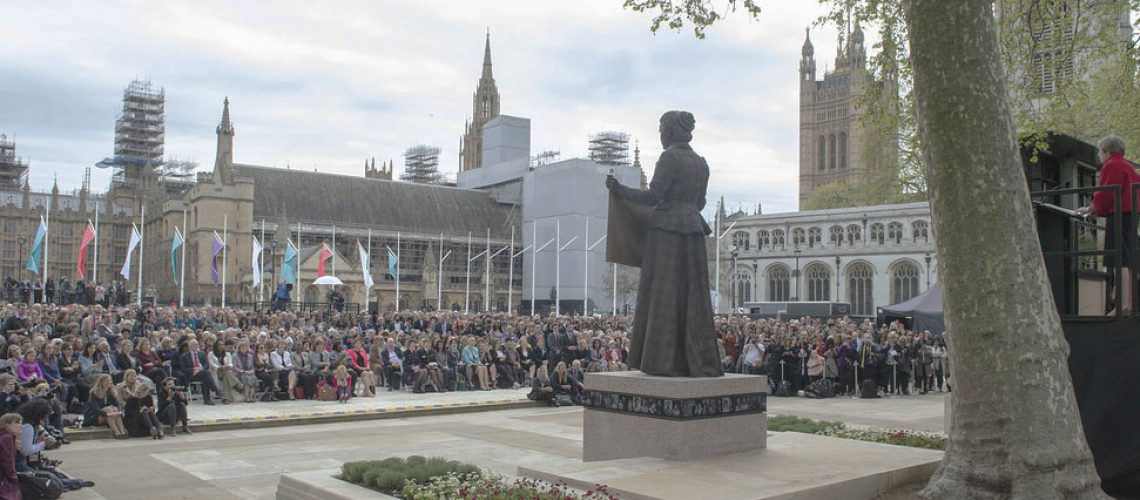Women in the UK did not gain universal suffrage until 1928, but the first milestone was reached in 1918, when some women became eligible to vote. On the centenary of this first victory, Parliament Square made way for a statue of a woman to commemorate the many who fought to secure universal suffrage
Among the dozen statues dotted around Parliament Square is just one of a woman, created by a woman following a campaign led by a woman. This unique statue is that of suffragist Millicent Fawcett, and it stands alongside monuments to Nelson Mandela, Sir Robert Peel, Winston Churchill, Mahatma Gandhi and Abraham Lincoln, among others.
There may be only one woman on the plinth, but the monument is a tribute to the many campaigners who persevered over many decades to gain universal suffrage, organising petitions, lobbying politicians, and taking part in numerous events and demonstrations, many of which took place or culminated outside the Houses of Parliament in the square where this statue now stands.
Fawcett joined the male statesmen on 24 April 2019, in the centenary year of some women gaining the right to vote. Created by Turner Prize-winning artist Gillian Wearing, the bronze monument was unveiled following a campaign by activist Caroline Criado Perez, who had previously persuaded the Bank of England to feature a woman on a bank note. Thanks to her, the current £10 note features writer Jane Austen.
Suffragist and women’s rights campaigner Fawcett was the younger sister of Elizabeth Garrett Anderson, the first woman to be entered on Britain’s medical register. Fawcett made it her lifetime’s work to secure women the right to vote. Her activism began in her teens and, aged just 19, she organised signatures for the first petition for women’s suffrage, even though she was too young to sign it herself.
In 1897, she was involved in the reorganisation of suffrage societies that led to the formation of the National Union of Women’s Suffrage Societies (NUWSS), an organisation that used peaceful tactics to campaign for women’s right to vote, such as organising petitions and lobbying MPs.
Fawcett was a suffragist, rather than a suffragette, preferring to take a constitutional approach to gain the vote, but she did not condemn the militant tactics of the Pankhursts’ Women’s Social and Political Union. In fact, many women were members of both organisations and took part in both non-militant and militant actions.
In 1907, Fawcett was part of a parade to celebrate women’s suffrage, organised as a deliberately peaceful demonstration to highlight the cause. About 3,000 women from around the country of all classes and of all ages converged on Hyde Park and marched to the Strand, taking part in a day of celebration. On the upside, the event was received well by both the public and the press but, on the downside, it became known as the Mud March, due to the cold and wet weather!

Following another reorganisation of the NUWSS, Fawcett became its president in 1907, a role in which she continued until 1919, when the organisation became the National Union of Societies for Equal Citizenship, following the granting of voting rights to some women. She was succeeded as president by Eleanor Rathbone, a social reformer and suffrage campaigner who was to become an MP 10 years later. Two years earlier Fawcett had led a delegation to meet Prime Minister Lloyd George and a year later she witnessed the debate in the House of Lords that passed the women’s suffrage clause to the Representation of the People Bill
With 50,000 members, the NUWSS was the largest organisation agitating for female suffrage at the time. Fawcett’s powerful and peaceful mass campaign was instrumental in securing this first extension of voting rights for women in 1918.
The plinth around the statue features many famous and not so famous suffragists and suffragettes – and a few men – who campaigned for women’s right to vote, including Sophia Duleep Singh, Emily Wilding Davidson, Louise Garrett Anderson, Annie Kenny, Eleanor Rathbone and Laurence Housman.
In 1913, Fawcett was awarded a brooch engraved with ‘For Steadfastness and Courage’, which the Fawcett Society still has today. The banner held by Fawcett reads: ‘Courage Calls to Courage Everywhere’, an extract from a speech she made following the death of suffragette Emily Wilding Davison, who was hit by the king’s horse during a protest at the Derby in 1913.
In addition to her suffrage work, Fawcett was co-founder of Newnham College at Cambridge University in 1871, one of the first English university colleges for women.
Fawcett died in 1929, having seen the fruition of her tireless campaigning over the decades with the introduction of universal women’s suffrage in 1928.
Main image shows the opening ceremony to unveil the statue of Millicent Fawcett on 24 April 2018, with former Prime Minister Teresa May on the far right addressing those present (Main photo: No 10 Downing Street)

